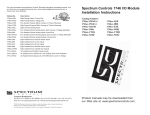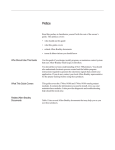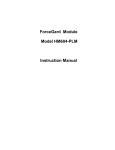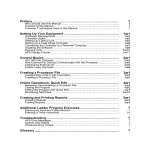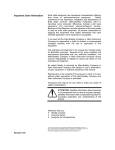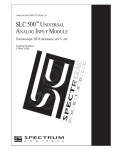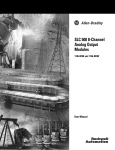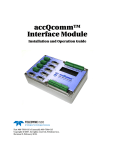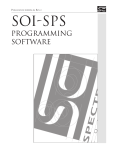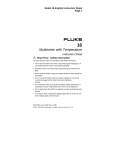Download Manual - Spectrum Controls, Inc.
Transcript
Owner’s Guide 0300128-03 Rev. D
SLC 500™ ISOLATED
ANALOG OUTPUT MODULES
Catalog Numbers
1746sc-INO4i
1746sc-INO4vi
Important Notes
1. Please read all the information in this owner’s guide before installing
the product.
2. The information in this owner's guide applies to hardware and
firmware version 1.0 or later.
3. This guide assumes that the reader has a full working knowledge of
the relevant processor.
Notice
The products and services described in this owner's guide are useful in a
wide variety of applications. Therefore, the user and others responsible
for applying the products and services described herein are responsible
for determining their acceptability for each application. While efforts
have been made to provide accurate information within this owner's
guide, Spectrum Controls assumes no responsibility for the accuracy,
completeness, or usefulness of the information herein.
Under no circumstances will Spectrum Controls be responsible or liable
for any damages or losses, including indirect or consequential damages
or losses, arising out of either the use of any information within this
owner's guide or the use of any product or service referenced herein.
No patent liability is assumed by Spectrum Controls with respect to the
use of any of the information, products, circuits, programming, or
services referenced herein.
The information in this owner's guide is subject to change without notice.
Limited Warranty
Spectrum Controls warrants that its products are free from defects in
material and workmanship under normal use and service, as described in
Spectrum Controls literature covering this product, for a period of 1 year.
The obligations of Spectrum Controls under this warranty are limited to
replacing or repairing, at its option, at its factory or facility, any product
which shall, in the applicable period after shipment, be returned to the
Spectrum Controls facility, transportation charges prepaid, and which
after examination is determined, to the satisfaction of Spectrum Controls,
to be thus defective.
This warranty shall not apply to any such equipment which shall have
been repaired or altered except by Spectrum Controls or which shall have
been subject to misuse, neglect, or accident. In no case shall the liability
of Spectrum Controls exceed the purchase price. The aforementioned
provisions do not extend the original warranty period of any product
which has either been repaired or replaced by Spectrum Controls.
Table Of Contents
Preface
Overview And
Specifications
Who Should Use This Guide ....................................................................... iii
What This Guide Covers ............................................................................. iii
Related Allen-Bradley Documents .............................................................. iii
Terms & Abbreviations You Should Know ................................................... iv
Chapter 1
General Features And Benefits .................................................................... 1
Detailed Specifications................................................................................. 2
Installing And Wiring Your
Module
Chapter 2
Avoiding Electrostatic Damage .................................................................... 6
Determining Power Requirements ............................................................... 6
Setting The DIP Switch ................................................................................ 7
Selecting A Rack Slot .................................................................................. 8
Inserting Your Module Into The Rack ........................................................... 8
Wiring Your Module .................................................................................... 10
Things To Consider Before
Using Your Module
Chapter 3
How The Processor Communicates With Your Module .............................. 13
Channel Update Time ................................................................................ 13
Temperature Calibration Time .................................................................... 14
Output Mode Change Time (-INO4vi only) ................................................ 14
Your Module’s Response To Slot Disabling ................................................ 14
Using Your Output Module
Chapter 4
Entering Your Module’s ID Code ................................................................ 15
Configuring Each Output Channel ............................................................. 18
Optional: Setting The Output Data Limits (or User-Defined Scale) ............ 21
Controlling Each Output Channel’s Signal ................................................. 24
Monitoring Each Output Channel............................................................... 25
Checking Each Output Channel’s Configuration And Status ..................... 25
Testing Your Module
Chapter 5
Inspecting Your Module .............................................................................. 29
Disconnecting Prime Movers ..................................................................... 30
Powering Up ............................................................................................... 30
Interpreting The LED Indicators ................................................................. 31
Interpreting I/O Error Codes ...................................................................... 31
Troubleshooting.......................................................................................... 32
ii
SLC 500™ Isolated Analog Output Modules
Maintaining Your Module
And Ensuring Safety
Chapter 6
Preventive Maintenance ............................................................................. 33
Safety Considerations ................................................................................ 33
Tables
Table 1. Related Allen-Bradley documents ................................................. iv
Table 2. Electrical specifications—module ................................................... 2
Table 3. Electrical specifications—outputs ................................................... 3
Table 4. Physical specifications .................................................................... 3
Table 5. Environmental specifications .......................................................... 4
Table 6. Backplane current consumed ......................................................... 7
Table 7. Channel update time (channels already enabled) ........................ 14
Table 8. Output module ID code ................................................................ 15
Table 9. Channel configuration word details, Output Words 4 and 5 ......... 18
Table 10. Data format definitions ............................................................... 20
Table 11. Channel status word details, Input Words 4 through 7 ............... 26
Table 12. LED definition ............................................................................. 31
Figures
Figure 1. Ferrite EMI suppressor for CE compliance ................................. 11
Figure 2. Wiring diagrams (showing differential outputs). .......................... 12
Figure 3. Output and input scans ............................................................... 13
Figure 4. Output and input words............................................................... 16
Figure 5. Example relationship between output signal and channel data .. 24
Figure 6. LED block ................................................................................... 31
Figure 7. Problem resolution flowchart ...................................................... 32
Preface
Read this preface to familiarize yourself with the rest of the owner’s
guide. This preface covers:
• who should use this guide
• what this guide covers
• related Allen-Bradley documents
• terms & abbreviations you should know
Who Should Use This
Guide
Use this guide if you design, install, program, or maintain a control
system that uses Allen-Bradley Small Logic Controllers.
You should have a basic understanding of SLC 500 products. You should
also understand electronic process control and the ladder program
instructions required to generate the electronic signals that control your
application. If you do not, contact your local Allen-Bradley
representative for the proper training before using these products.
What This Guide Covers
Related Allen-Bradley
Documents
This guide covers the 1746sc-INO4i and 1746sc-INO4vi isolated analog
output modules. It contains the information you need to install, wire, use,
and maintain these modules. It also provides diagnostic and
troubleshooting help should the need arise.
Table 1 lists several Allen-Bradley documents that may help you as you
use these products.
iv
SLC 500™ Isolated Analog Output Modules
Table 1. Related Allen-Bradley documents
Allen-Bradley Doc. No.
Title
1747-2.30
SLC 500 System Overview
SGI-1.1
Application Considerations for Solid State Controls
1770-4.1
Allen-Bradley Programmable Controller Grounding and
Wiring Guidelines
1747-6.2
Installation & Operation Manual for Modular Hardware
Style Programmable Controllers
1747-NI001
Installation & Operation Manual for Fixed Hardware Style
Programmable Controllers
1747-6.4
Allen-Bradley Advanced Programming Software (APS)
User Manual
1747-6.11
Allen-Bradley Advanced Programming Software (APS)
Reference Manual
1747-6.3
Getting Started Guide for Advanced Programming
Software (APS)
ABT-1747-TSG001
SLC 500 Software Programmers’s Quick Reference
Guide
1747-NP002
Allen-Bradley HHT (Hand-Held Terminal) User Manual
1747-NM009
Getting Started Guide for HHT (Hand-Held Terminal)
SD499
Allen-Bradley Publication Index
AG-7.1
Allen-Bradley Industrial Automation Glossary
To obtain a copy of any of the Allen-Bradley documents listed, contact
your local Allen-Bradley office or distributor.
Terms & Abbreviations
You Should Know
You should understand the following terms and abbreviations before
using this guide. For the definitions of terms not listed here, refer to
Allen-Bradley’s Industrial Automation Glossary, Publication AG-7.1
Attenuation – The reduction in magnitude of a signal as it passes
through a system. The opposite of gain.
Channel – Refers to one of the sets of signal interfaces available on a
module’s terminal block.
Channel update time – For analog outputs, the time required for the
channel to convert the data received from the processor to analog output
signals at the terminals.
Chassis – See rack.
Preface
v
Common mode voltage – The voltage difference between the negative
terminal and analog common during normal differential operation.
Common mode voltage range – The largest voltage difference allowed
between either the positive or negative terminal and analog common
during normal differential operation.
Configuration word – Contains the channel configuration information
needed by the module to configure and operate each channel. Information
is written to the configuration word through the logic supplied in your
ladder program.
D/A – Refers to digital-to-analog conversion. The conversion produces
an analog output signal whose magnitude is proportional to the digital
value.
dB (decibel) – A logarithmic measure of the ratio of two signal levels.
Data scaling - The data format that you select to define the logical
increments of the channel data word.
Data word – A 16-bit integer that represents the value of the analog
output channel. The channel data word is valid only when the channel is
enabled and there are no channel errors.
Differential operation – The difference in voltage between a channel’s
positive and negative terminals.
Effective resolution – The number of bits in the channel data word that
do not vary due to noise.
Full-scale error (gain error) – The difference in slope between the
actual and ideal analog transfer functions.
Full-scale range (FSR) – The difference between the maximum and
minimum specified analog values.
Gain drift – The change in full-scale transition voltage measured over
the operating temperature range of the module.
LSB (least significant bit) – The bit that represents the smallest value
within a string of bits. The “weight” of this value is defined as the fullscale range divided by the resolution.
Maximum differential voltage – The largest voltage difference allowed
between the negative terminal and positive terminal during normal
differential operation.
Module ID code – A unique number associated with each 1746 I/O
module. The code defines for the processor the type of I/O or specialty
module residing in a specific slot in the 1746 chassis.
Module update time – See channel update time.
vi
SLC 500™ Isolated Analog Output Modules
Overall accuracy – The worst-case deviation of the signal over the full
range, expressed in percent of full scale.
Rack – A hardware assembly that houses devices such as I/O modules,
adapter modules, processor modules, and power supplies.
Repeatability – The closeness of agreement among repeated
measurements of the same variable under the same conditions.
Resolution – The smallest detectable change in a measurement, typically
expressed in engineering units (e.g. 0.15 °C) or as a number of bits. For
example, a 12-bit system has 4096 possible output states. It can therefore
measure 1 part in 4096. See also effective resolution.
Safe state – The state of the analog outputs entered when the processor is
not in RUN mode. The user must ensure that this state is a safe state for
the application.
Status word – Contains status information about the channel’s current
configuration and operational state. You can use this information in your
ladder program to determine whether the channel data word is valid.
Step response time – The time required for the output signal to reach
95% of its expected, final value, given a full-scale step change in the
output data word.
Useful resolution – See effective resolution.
Chapter 1
Overview And Specifications
The 1746sc-INO4i provides four isolated channels of current outputs,
while the 1746sc-INO4vi provides four isolated channels of current or
voltage outputs (in any combination). In both modules, the voltage and/or
current ranges are independently configurable for each channel. These
modules also provide new, advanced features to make your control
systems more dependable and flexible.
Read this chapter to familiarize yourself further with your isolated analog
module (shown above). This chapter covers:
• general features and benefits
• detailed specifications
General Features And
Benefits
Increased System Accuracy and Reliability
Both modules provide 750 Vdc channel-to-channel isolation, which
means no electrical noise crosstalk between channels (resulting in a high
usable resolution). They also provide 750 Vdc field-wiring-to-backplane
isolation to protect the processor and rack. These modules even feature
onboard temperature compensation to maintain their accuracy with
fluctuating ambient temperatures, which is important for crowded control
cabinets.
Reduced System Costs
Because isolation is built into these modules, you can improve system
accuracy while saving hundreds of dollars on system installation costs.
Expensive, external isolation blocks are simply not required. They also
2
SLC 500™ Isolated Analog Output Modules
provide a single-slot solution for applications requiring up to four, mixed
analog outputs, so you don’t have to buy more I/O than you need.
State-of-the-Art Performance
These modules incorporate proprietary Allen-Bradley technology, so they
operate and perform like the latest Allen-Bradley products. They also
provide 16-bits of resolution, user-programmable range settings,
continuous temperature compensation (no field calibration), software
configuration, programmable output limits, and programmable safe states
in case of a fault.
Detailed Specifications
Table 2. Electrical specifications—module
Backplane Current Consumption (maximum)
1746sc-INO4i
1746sc-INO4vi
Backplane Power Consumption (typical)
120 mA @ 5 Vdc
250 mA @ 24 Vdc
120 mA @ 5 Vdc
250 mA @ 24 Vdc
0.6 W
Number Of Channels
4 (differential, individually isolated)
I/O Chassis Location
Any 1746 I/O module slot except slot 0
A/D Conversion Method
Calibration
Opto-Electrical Isolation
Module ID Code
1746sc-INO4i
1746sc-INO4vi
Thermal Dissipation
Sigma-Delta
Factory calibrated
Temperature compensation once a minute
750 Vdc channel-to-channel
750 Vdc field wiring-to-backplane
3521
3519
4.5 W maximum
Chapter 1: Overview And Specifications
3
Table 3. Electrical specifications—outputs
Output Current Ranges
(selectable for each channel)
4 to 20 mA
0 to 20 mA
0 to 21 mA
Output Voltage Ranges—INO4vi only
(selectable for each channel)
-10 to +10 Vdc
0 to 10 Vdc
0 to 5 Vdc
1 to 5 Vdc
SLC Communication Formats
(selectable for each channel)
Scaled engineering units
Scaled for PID
Proportional counts
1746-NO4 format
User-defined scale
Output Impedance
Current Outputs
Voltage Outputs—INO4vi only
Greater than 1 MΩ
Less than 1.0 Ω
Load Range
Current Outputs
Voltage Outputs—INO4vi only
0 to 500 Ω
1 kΩ and greater
Max. Current, Voltage Mode—INI4vi only
Output Step Response Time
10 mA
1 ms (0–95% of full scale)
Channel Update Time (maximum)
33.7 ms for all 4 channels in parallel
Output Resolution
Current Outputs
Voltage Outputs—INO4vi only
16-bit
366 nA/count
320 µV/count
Overall Accuracy
Current Outputs
0.08% of full scale @ 25 °C
0.15% of full scale @ 60 °C
0.08% of full scale @ 25 °C
0.35% of full scale @ 60 °C
Voltage Outputs—INO4vi only
Table 4. Physical specifications
LED Indicators
Four green channel status indicators, one for each channel
One green module status indicator
Recommended Cable
Belden 8761 (shielded, twisted-pair) or equivalent
Wire Size (maximum)
One 12–24 AWG wire per terminal
Terminal Block
Removable (supplied)
4
SLC 500™ Isolated Analog Output Modules
Table 5. Environmental specifications
Operating Temperature
0 to 60 °C (32 to 140 °F)
Storage Temperature
-40 to 85 °C (-40 to 185 °F)
Relative Humidity
5 to 95% non-condensing
Certifications
Hazardous Environment Classifications
UL/CUL and CE
Class I Division 2 Groups ABCD
Chapter 2
Installing And Wiring Your Module
Read this chapter to install and wire your module. This chapter covers:
• avoiding electrostatic damage
• determining power requirements
• setting the DIP switch
• selecting a rack slot
• inserting your module into the rack
• wiring your module
Note that although your module has a jumper on its printed circuit board,
this jumper is for the manufacturer’s use only. Also, your module was
calibrated by the manufacturer, so you don’t need to perform this task.
Important - For UL and CUL compliance, power and input/output (I/O)
wiring must be in accordance with Class I, Division 2, wiring methods
[Article 501-4 (b) of the National Electrical Code , NFPA 70] and in
accordance with the authority having jurisdiction. Also, you must observe
the warnings shown below. Failure to observe these warnings can cause
personal injury.
!
WARNING
EXPLOSION HAZARD
Substitution of components may impair suitability for
Class I, Division 2;
When in hazardous locations, turn off power before
replacing or wiring modules;
Do not disconnect equipment unless power has been
switched off or the area is known to be non-hazardous.
6
SLC 500™ Isolated Analog Output Modules
The following documents contain information that may help you as you
install and wire your module:
• National Electrical Code, published by the National Fire Protection
Association of Boston, MA
• IEEE Standard 518-1977, Guide for the Installation of Electrical
Equipment to Minimize Electrical Noise Inputs to Controllers from
External Sources
• IEEE Standard 142-1982, Recommended Practices for Grounding of
Industrial and Commercial Power Systems
• Noise Reduction Techniques in Electronic Systems, by Henry W. Ott;
published by Wiley-Interscience of New York in 1976
Avoiding Electrostatic
Damage
Guard against electrostatic damage by observing the following
precautions:
!
CAUTION
ELECTROSTATICALLY SENSITIVE COMPONENTS
• Before handling the module, touch a grounded object to
rid yourself of electrostatic charge.
• When handling the module, wear an approved wrist strap
grounding device.
• Handle the module from the front, away from the
backplane connector. Do not touch backplane
connector pins.
• Keep the module in its static-shield container when not
in use or during shipment.
Failure to observe these precautions can degrade the module’s
performance or cause permanent damage.
Determining Power
Requirements
The backplane of the SLC 500 system can provide both 5 Vdc and 24
Vdc power. The following table shows the maximum current consumed
by your module when using these power sources:
Chapter 2: Installing And Wiring Your Module
7
Table 6. Backplane current consumed
24 Vdc *
Catalog Number
5 Vdc
w/o ext. supply
w/ ext. supply
1746-sc-INO4i
120 mA
250 mA
0 mA
1746sc-INO4vi
120 mA
250 mA
0 mA
* The 1746sc-INO4i and 1746sc-INO4vi output modules can use an external 24 Vdc power
supply to reduce backplane loading. To use an external 24 Vdc power supply, you must set
your module’s DIP switch as indicated in the following subsection.
Use Table 6 to calculate the total load on the system power supply. For
more information, see the Allen-Bradley system Installation and
Operation Manual.
The 1746sc-INO4i and 1746sc-INO4vi output modules have an external
24 Vdc power switch, SW1, giving you the option of using an external
power supply:
• With the switch in the RACK position, the module draws all its power
from the backplane of the SLC system.
• With the switch in the EXT position, the module draws its 24 Vdc
power from an external power source; however, the module still draws
its 5 Vdc power from the backplane.
The switch, SW1, is located in the bottom corner of the module’s large
circuit board.
RACK
1
SW1
Setting The DIP Switch
EXT
8
SLC 500™ Isolated Analog Output Modules
Selecting A Rack Slot
Two factors determine where you should install your module in the rack:
ambient temperature and electrical noise. When selecting a slot for your
module, try to position your module:
• in a rack close to the bottom of the enclosure (where the air is cooler)
• away from modules that generate significant heat, such as 32-point
input/output modules
• in a slot away from ac or high-voltage dc modules, hard contact
switches, relays, and ac motor drives
• away from the rack power supply (if using a modular system)
Remember that in a modular system, the processor always occupies the
first slot of the rack.
Inserting Your Module
Into The Rack
!
CAUTION
POSSIBLE EQUIPMENT OPERATION
Before installing or removing your module, always
disconnect power from the SLC 500 system and from any
other source to the module (in other words, don’t “hot
swap” your module), and disconnect any devices wired to
the module.
Failure to observe this precaution can cause unintended
equipment operation and damage.
When inserting your module into the rack, you do not need to remove the
supplied 16-position terminal block from the module. If, however, you do
remove the terminal block, apply the supplied write-on label to the
terminal block, and use the write-on label to identify your module’s
location.
To remove the terminal block, unscrew the two retaining screws at the
top and bottom of the terminal block, and using a screwdriver or needlenose pliers, carefully pry the terminal block loose.
Chapter 2: Installing And Wiring Your Module
9
To insert your module into the rack, follow these steps:
1. Align the circuit board of your module with the card guides at the top
and bottom of the chassis.
2. Slide your module into the chassis until both top and bottom retaining
clips are secure. Apply firm even pressure on your module to attach it
to its backplane connector. Never force your module into the slot.
Cover all unused slots with the Card Slot Filler, Allen-Bradley part
number 1746-N2.
To remove your module, press the retaining clips at the top and bottom of
your module and slide it out.
10
SLC 500™ Isolated Analog Output Modules
Wiring Your Module
To wire the terminal block, you need:
• a small, flat-blade screwdriver
• Belden 8761 (shielded, twisted pair) cable or equivalent
!
CAUTION
POSSIBLE EQUIPMENT OPERATION
Before wiring your module, always disconnect power from
the SLC 500 system and from any other source to the
module.
Failure to observe this precaution can cause unintended
equipment operation and damage.
Before wiring the terminal block, take some time to plan your system:
• Ensure that the SLC 500 system is installed in a NEMA-rated
enclosure and that the SLC 500 system is properly grounded.
• Ensure that the load resistance for a current output channel is less than
500 Ω.
• Ensure that the load resistance for a voltage output channel is greater
than 1 kΩ.
• Route the field wiring away from any other wiring and as far as
possible from sources of electrical noise, such as motors, transformers,
contactors, and ac devices. As a general rule, allow at lease 6 in.
(about 15.2 cm) of separation for every 120 V of power.
• Routing the field wiring in grounded a conduit can reduce electrical
noise further.
• If the field wiring must cross ac or power cables, ensure that they
cross at right angles.
To wire your module, follow these steps:
1 Determine the length of cable you need to connect a channel to its
field device. Remember to include additional cable to route the drain
wire and foil shield to their ground points.
2. At each end of the cable, strip some casing to expose the individual
wires.
3. Trim the exposed signal wires to 2 in. lengths. Strip about 3/16 in.
(about 5 mm) of insulation away to expose the end of each wire.
Chapter 2: Installing And Wiring Your Module
11
4. At one end of the cable, twist the drain wire and foil shield together,
bend them away from the cable, and apply shrink wrap.
Foil Shield and Drain Wire
Insulation
Black Wire
Clear Wire
5. At the other end of the cable, cut the drain wire and foil shield back to
the cable and apply shrink wrap.
Insulation
Black Wire
Clear Wire
6. Connect the wires to the terminal block and field device as shown in
the following figures and table. The recommended maximum torque is
5 in-lb (0.565 Nm) for all terminal screws.
To guard against electrostatic damage and improve chassis grounding,
connect one of the shield pins on the terminal block of your module to
the chassis itself.
Important: For CE compliance, Ferrite EMI Suppressors are needed
on each channel’s terminal block connection. Apply the suppressor
close to the module terminal block, as shown below. A Steward Part
28B2024-0A0 or equivalent is recommended. The Steward 28B20240A0 has an impedance of 157 Ω at 25 MHz, 256 Ω at 100 MHz, and
can accommodate one turn of wire.
Figure 1. Ferrite EMI suppressor for CE compliance
Module
7. Repeat steps 1 through 6 for each channel on your module.
A system may malfunction due to a change in its operating environment.
After installing and wiring your module, check system operation. See the
Allen-Bradley system Installation and Operation Manual for more
information.
12
SLC 500™ Isolated Analog Output Modules
Figure 2. Wiring diagrams (showing differential outputs).
-INO4i
Not used
0
Current output, ch. 0
1
Analog ground, ch. 0
2
Chassis ground
3
Not used
4
Current output, ch. 1
5
Analog ground, ch. 1
6
Not used
7
Current output, ch. 2
8
Analog ground, ch. 2
9
Chassis ground
10
Not used
11
Current output, ch. 3
12
Analog ground, ch. 3
13
+24 Vdc external
14
Ground external
15
+
load
-
+
load
-
Shielded, twisted-pair cable with shield
connected to ground only at one end
To guard against electrostatic damage
and improve module grounding,
connect a chassis ground pin directly
to a rack mounting bolt.
Ext. pwr.
supply
24 Vdc power supply if
external power is selected.
-INO4vi Voltage output, ch. 0
0
Current output, ch. 0
1
Analog ground, ch. 0
2
Chassis ground
3
Voltage output, ch. 1
4
Current output, ch. 1
5
Analog ground, ch. 1
6
Voltage output, ch. 2
7
Current output, ch. 2
8
Analog ground, ch. 2
9
Chassis ground
10
Voltage output, ch. 3
11
Current output, ch. 3
12
Analog ground, ch. 3
13
+24 Vdc external
14
Ground external
15
+
load
+
load
-
Shielded, twisted-pair cable with shield
connected to ground only at one end
To guard against electrostatic damage
and improve module grounding,
connect a chassis ground pin directly
to a rack mounting bolt.
Ext. pwr.
supply
24 Vdc power supply if
external power is selected.
Chapter 3
Things To Consider Before Using
Your Module
Read this chapter to familiarize yourself with:
• how the processor communicates with your module
• channel update time
• channel enable and disable times
• temperature calibration time
• output mode change time (-INO4vi only)
• your module’s response to slot disabling
How The Processor
Communicates With Your
Module
Your processor transfers data to (and receives data from) the processor
through an image table residing in the data files of your processor. The
processor updates this image table once during each scan of your ladder
program. Figure 4 shows the image table for your output module.
Figure 3. Output and input scans
SLC 5/0X
Data Files
Slot e
-INO4
Output & Input Image
Output
Scan
Output Image
8 Words
Output Image
Slot e
Input Image
Channel Update Time
Input
Scan
Input Image
8 Words
For an output module, channel update time is the time required for the
module to convert the channel data received from the processor to an
analog output signal at the terminals.
14
SLC 500™ Isolated Analog Output Modules
In general, you can reduce the channel update time by disabling unused
channels, as shown in the following table:
Table 7. Channel update time (channels already enabled ①)
# of ch. enabled
Time
Current output
1
2
3
4
24.3 ms (typical)
27.3
30.7
33.7
Voltage output
(-INO4vi only)
1
2
3
4
24.3
26.9
30.1
32.7
① When the module must enable a disabled channel, add 1.2 ms to the time shown.
For the fastest possible channel update time, enable only one channel.
Temperature Calibration
Time
About once a minute, if no update is occurring, your module performs a
temperature calibration. During this time, your module cannot convert
the channel data received from the processor to an analog output signal at
the terminals. The temperature calibration takes about 56.2 ms.
Output Mode Change Time
(-INO4vi only)
Whenever the output mode is changed (usually on module start-up), the
power supplied to the isolated channels has to go through a power cycle,
affecting all 4 channels. During this time, your module cannot convert
channel data from the processor to analog output signals at the terminals.
The power cycle takes about 5.2 seconds.
Your Module’s Response
To Slot Disabling
By writing to the status file in the modular SLC processor, you can
disable any chassis slot. Refer to your SLC programming manual for the
slot disable/enable procedure.
!
CAUTION — POSSIBLE EQUIPMENT OPERATION
Always understand the implications of disabling a module
before using the slot disable feature.
Failure to observe this precaution can cause unintended
equipment operation.
When you disable an output module’s slot, the module holds its outputs
in their last state. When you re-enable the output module’s slot, the data
that is in the processor image table is converted to an analog output
signal during the next scan. Slot disabling only affects enabled channels.
Chapter 4
Using Your Output Module
Read this chapter to:
• enter your output module’s ID code
• configure each output channel
• set the output data limits or user-defined scale (optional)
• control each output channel’s signal
• monitor each output channel
• check each output channel’s configuration and status
To use your module, you need:
• programming equipment
• Allen-Bradley Advanced Programming Software (APS)
For help with APS, see the Getting Started Guide for APS.
Entering Your Module’s
ID Code
Before using your module, you must configure the slot your module is in
by entering your module’s ID code in APS.
When using APS version 6 or later, simply select your module from the
list of modules on the system I/O configuration display to automatically
enter the ID code.
With earlier versions of APS (4 through 5), you must manually enter the
ID code. To enter your module’s ID code, select “other” from the list of
modules on the APS system I/O configuration display, and enter your
module’s ID code at the prompt. The module ID code for your module is:
Table 8. Output module ID code
Catalog Number
Module ID Code
1746sc-INO4i
3521
1746sc-INO4vi
3519
16
SLC 500™ Isolated Analog Output Modules
No special I/O configuration (SPIO CONFIG) information is required.
The module ID code automatically assigns the correct number of input
and output words for the processor to access.
Figure 4. Output and input words
Address
O:e.0
0
15
Channel 0 Output Data Word
O:e.1
Channel 1 Output Data Word
O:e.2
Channel 2 Output Data Word
O:e.3
Channel 3 Output Data Word
O:e.4
Channel 1 Configuration Byte
Channel 0 Configuration Byte
O:e.5
Channel 3 Configuration Byte
Channel 2 Configuration Byte
O:e.6
Low Value of Output Data Limit (or User-Defined Scale)
O:e.7
High Value of Output Data Limit (or User-Defined Scale)
Address
I:e.0
0
15
Channel 0 Data Word
I:e.1
Channel 1 Data Word
I:e.2
Channel 2 Data Word
I:e.3
Channel 3 Data Word
I:e.4
Channel 0 Status Word
I:e.5
Channel 1 Status Word
I:e.6
Channel 2 Status Word
I:e.7
Channel 3 Status Word
Example – If you want to reconfigure channel 2 on your module, and it
is in slot 4 of the SLC chassis, you would modify the configuration word
at address O:4.5. Alternatively, if you want to obtain the status of channel
2, you would check the status word at address I:4.6.
Chapter 4: Using Your Output Module
17
Output Image
The 8-word, output image (defined as the output from the SLC processor
to your module) defines how each channel on your module works:
• The output data words control output signal levels for each channel.
• The configuration bytes replace configuration DIP switches on your
module. In your output module, each word configures two channels
(one independent byte per channel).
• The output limit values define minimum and maximum output data
values, if output data limits are properly enabled.
• The user-defined scale values define how your module scales output
data values to analog output signals, if the User-Defined Scale data
format is selected.
For more information on the user-defined scale and output data limits,
see Optional: Setting The Output Data Limits (or User-Defined Scale),
later in this chapter.
Input Image
The 8-word, input image (defined as the input from your module to the
SLC processor) holds the data received by your module and provides the
status (configuration and operational state) of each channel.
Important – A data word is valid only when the channel is enabled and
there are no channel errors. A status word is valid only when the channel
is enabled and the module has processed all configuration changes.
18
SLC 500™ Isolated Analog Output Modules
Configuring Each
Output Channel
Address
O:e.4
After installing your module, you must configure each channel by setting
bit values in each configuration word. Output words 4 and 5 of the output
image file (addresses O:e.4 and O:e.5) configure channels 0–1 and 2–3,
respectively.
0
15
O:e.5
Channel 1 Configuration Byte
Channel 0 Configuration Byte
Channel 3 Configuration Byte
Channel 2 Configuration Byte
A detailed explanation appears in the following table:
Table 9. Channel configuration word details, Output Words 4 and 5 (O:e.4 and O:e.5)
To select…
Use these bit settings...
For Channel 1 (and 3)
Bit: 15 14 13 12
11 10
For Channel 0 (and 2)
9
Output channel disable
Output channel enable
7
6
5
4
3
2
1
0
1
±10 Vdc output range (-INO4vi only)
1–5 Vdc output range (-INO4vi only)
0–5 Vdc output range (-INO4vi only)
0–10 Vdc output range (-INO4vi only)
0–20 mA output range
4–20 mA output range
0–21 mA output range
Invalid
0
0
0
0
1
1
1
1
Engineering units
Scaled for PID
Proportional counts
1746-NO4 compatible format
User-defined scale
Invalid
Invalid
Invalid
Reset output on fault
Hold last value on fault
8
0
0
0
0
1
1
1
1
0
1
0
0
1
1
1
0
0
1
0
0
1
1
0
0
1
1
0
0
1
0
1
0
1
0
1
0
1
0
0
0
0
1
1
1
1
0
1
0
1
0
0
1
1
0
0
0
0
1
1
1
1
0
1
0
0
1
1
1
0
0
1
0
1
0
1
0
0
1
1
0
0
1
1
0
0
1
1
0
1
0
1
0
1
0
1
Chapter 4: Using Your Output Module
19
Output Channel Enable (configuration bits 0 and 8)
Use this bit to enable or disable a channel. To minimize update times,
disable any unused channels.
When you set the channel enable bit to one, the module reads the
configuration word. Before accepting any new data as valid, verify that
the status word (described in the last subsection of this chapter) reflects
the changes you made.
While the channel enable bit is set to zero, the channel data word and
status word are also set to zero. When you reset the channel enable bit to
one, the channel data word remains set to zero until your module updates
the channel status word.
Output Range (configuration bits 1–3 and 9–11)
Use this bit field to configure the channel for the type of output device
you have connected to the module.
Data Format (configuration bits 4–6 and 12–14)
Use this bit field to select one of the following formats:
• engineering units (mV or nA)
• scaled for PID (works with the SLC PID instruction)
• proportional counts (two’s complement binary)
• 1746-NO4 compatible format (the format used by the 1746-NO4)
• user-defined scale
These data formats are defined in the following table:
20
SLC 500™ Isolated Analog Output Modules
Table 10. Data format definitions
Selected
Data Value (counts)
Output Range Min.
Max.
Corresponding Signal
Min.
Max.
Engineering Units
±10 V
0–10 V
0–5 V
1–5 V
0–20 mA
0–21 mA
4–20 mA
-10250
-500
-500
+500
0
0
+3500
+10250
+10250
+5500
+5500
+20500
+21500
+20500
-10.25 V
-0.50 V
-0.50 V
+0.50 V
0.0 mA
0.0 mA
+3.5 mA
+10.25 V
+10.25 V
+5.50 V
+5.50 V
+20.5 mA
+21.5 mA
+20.5 mA
Scaled for PID
±10 V
0–10 V
0–5 V
1–5 V
0–20 mA
0–21 mA
4–20 mA
0
0
0
0
0
0
0
+16383
+16383
+16383
+16383
+16383
+16383
+16383
-10 V
0V
0V
+1 V
0 mA
0 mA
+4 mA
+10 V
+10 V
+5 V
+5 V
+20 mA
+21 mA
+20 mA
Proportional Counts ±10 V
0–10 V
0–5 V
1–5 V
0–20 mA
0–21 mA
4–20 mA
-32768
-32768
-32768
-32768
-32768
-32768
-32768
+32767
+32767
+32767
+32767
+32767
+32767
+32767
-10.25 V
-0.50 V
-0.50 V
+0.50 V
0.0 mA
0.0 mA
+3.5 mA
+10.25 V
+10.25 V
+5.50 V
+5.50 V
+20.5 mA
+21.5 mA
+20.5 mA
1746-NO4Compatible ①
±10 V
0–10 V
0–5 V
1–5 V
0–20 mA
0–21 mA
4–20 mA
-32768
0
0
+3277
0
0
+6242
+32767
+32767
+16384
+16384
+31208
+32767
+31208
-10 V
0V
0V
+1 V
0 mA
0 mA
+4 mA
+10 V
+10 V
+5 V
+5 V
+20 mA
+21 mA
+20 mA
User-Defined
Scale
±10 V
0–10 V
0–5 V
1–5 V
0–20 mA
0–21 mA
4–20 mA
-10.25 V
-0.50 V
-0.50 V
+0.50 V
0.0 mA
0.0 mA
+3.5 mA
+10.25 V
+10.25 V
+5.50 V
+5.50 V
+20.5 mA
+21.5 mA
+20.5 mA
Data Format
See note ➁
① Provides direct compatibility with the 1746-NO4 module.
➁ For the user-defined scale, the data in output words 6 and 7 determine the count limits.
See the next subsection, Optional: Setting The Output Data Limits (or User-Defined Scale),
for information on the User-Defined Scale data format.
Chapter 4: Using Your Output Module
21
Reset Output Or Hold Last Value On Fault
(configuration bits 7 and 15)
Use this bit to select how your module responds to a fault:
• If you set this bit to 1, your module holds the output signal at its last
value when it detects a fault.
• If you set this bit to 0, your module resets the output signal to the
power-up setting (0 V or 0 mA) when it detects a fault.
Optional: Setting The
Output Data Limits (or
User-Defined Scale)
Words 6 and 7 of the output image file (addresses O:e.6 and O:e.7) let
you define either:
• the low and high values of the output data limits
or
• the low and high values of the user-defined scale, if the User-Defined
Scale data format is selected
Address
O:e.6
O:e.7
0
15
Low Value of Output Data Limit (or User-Defined Scale)
High Value of Output Data Limit (or User-Defined Scale)
If you do not want to use user-defined scaling or output data limiting, set
output words 6 and 7 to zero. Setting output words 6 and 7 to zero
disables output data limiting and invalidates user-defined scaling.
Because they share the same output words, you cannot use output data
limiting with the User-Defined Scale data format.
Important – The values in output words 6 and 7 apply to all four
channels. If you want to use user-defined scaling or output data limiting,
you must set all four channels to the same data format.
Output Data Limits
For added safety, the 1746sc-INO4i and 1746sc-INO4vi output modules
let you define limits for the values in the output data words of all four
channels. These data limits, in turn, limit the output signals that your
module provides. When an output data word exceeds the data limit, the
output value is truncated to the limit.
You can use output data limiting to prevent PID loops from exceeding
safety limits, to prevent operators from inadvertently setting incorrect
values, etc.
To properly enable output data limiting, the low and high output limits
(output words 6 and 7, respectively) musts be non-zero and non-equal,
22
SLC 500™ Isolated Analog Output Modules
and the low limit (output word 6) must be lower than the high limit
(output word 7).
Example – Suppose you have four valves with a ±10 V operating range,
and you want to use the Engineering Units data format. For this
application, you would use the following bit settings for the channel
configuration bytes (output words 4 and 5):
Address
O:e.4
15
0
0
0
0
0
0
0
1
0
0
0
0
0
0
0
0
1
O:e.5
0
0
0
0
0
0
0
1
0
0
0
0
0
0
0
1
Suppose, also, that you would like to set the output limits to -2 V and
+8 V. After entering the above bit settings for output words 4 and 5, you
would enter the following for output words 6 and 7:
Address
O:e.6
15
1
1
1
1
1
0
0
0
0
0
1
1
0
0
0
0
0
O:e.7
0
0
0
1
1
1
1
1
0
1
0
0
0
0
0
0
Your module will now limit the output signal as shown below.
+10.25 V
+8 V
Data Limit High
Output Signal
-2 V
Data Limit Low
-10.25 V
Note that whenever the requested output data values meet or attempt to
exceed the output data limits, your module sets bits 10 or 11 in the
channel status word to indicate a limit error. Note also that words 0
through 3 of the input image file (addresses I:e.0 through I:e.3) reflect the
requested output data values and are not truncated.
Chapter 4: Using Your Output Module
23
User-Defined Scale
For special applications, the 1746sc-INO4i and 1746sc-INO4vi output
modules let you define a custom data format. This “user-defined scale” is
very similar to the “proportional counts” data format—except that instead
of converting the output data to an output signal using a previously
defined scale (-32,768 to 32,767), your module converts the output data
using a scale defined by the values in output words 6 (low limit of scale)
and 7 (high limit of scale).
The high limit value must be greater than the low limit value for proper
operation. Also, the difference between the low and high values should
be greater than 1024 counts. If the difference between the low and high
values is less than 1024 counts, unexpected results can occur (especially
at the extreme ends of the range).
You select the data format for each channel using that channel’s
configuration bits, described in the previous subsection, Configuring
Each Output Channel.
The following equations show you how to convert user-defined scale
units (or any type of units) to engineering units, and vice versa:
S = {(U - Ulow) × (∆S) ÷ (∆U)} + Slow
D = {(S - Slow) × (∆U) ÷ (∆S)} + Ulow
where
S = signal value (in engineering units, such as psi)
Slow = low limit of signal value
Shigh = high limit of signal value
∆S = Shigh - Slow
D = data value (user-defined scale)
Ulow = low value of user-defined scale
Uhigh = high value of user-defined scale
∆U = Uhigh - Ulow
Example – Suppose you have a valve with a 4–20 mA range, and you
want your scale to go from 100 to 9999 counts. For a 4–20 mA output
with user-defined scaling, your module sets the signal limits to 3.5 mA
and 20.5 mA (see Table 14). After entering 100 and 9999 into output
words 6 and 7, respectively, the relationship between data value (counts)
and output signal would be as follows:
24
SLC 500™ Isolated Analog Output Modules
Figure 5. Example relationship between output signal and
channel data
Data Value
9999
100
3.5 mA
20.5 mA
Signal
Value
In the preceding example...
Controlling Each Output
Channel’s Signal
S low = 3.5
Ulow = 100
Shigh = 20.5
Uhigh = 9999
∆S = 17
∆U = 9899
Output words 0 through 3 determine the output signal levels for channels
0 through 3, respectively. The output signal level depends on the output
range and data format selected.
Address
O:e.0
0
15
Channel 0 Output Data Word
O:e.1
Channel 1 Output Data Word
O:e.2
Channel 2 Output Data Word
O:e.3
Channel 3 Output Data Word
Chapter 4: Using Your Output Module
Monitoring Each Output
Channel
The requested output data values are reflected in words 0 through 3 of the
input image file (addresses I:e.0 through I:e.3). Whenever a channel is
disabled, its data word is reset to zero.
Address
I:e.0
Checking Each Output
Channel’s Configuration
And Status
25
0
15
Channel 0 Data Word
I:e.1
Channel 1 Data Word
I:e.2
Channel 2 Data Word
I:e.3
Channel 3 Data Word
Words 4 through 7 of the input image file (addresses I:e.4 through I:e.7)
reflect the configuration and status of each channel. Use the data
provided in these status words to determine if the configuration data for
any channel is valid.
Address
I:e.4
0
15
Channel 0 Status Word
I:e.5
Channel 1 Status Word
I:e.6
Channel 2 Status Word
I:e.7
Channel 3 Status Word
Whenever a channel is disabled, its status word is set to zero.
A detailed explanation appears in Table 12.
SLC 500™ Isolated Analog Output Modules
26
Table 11. Channel status word details, Input Words 4 through 7 (I:e.4 through I:e.7)
These bit settings in the status word
Bit: 15 14 13 12
11 10
Indicate this
9
8
7
6
5
4
3
2
1
0
0
1
0
0
0
1
1
1
0
0
0
0
1
0
1
0
1
0
1
0
1
0
1
0
1
0
1
0
1
0
1
0
0
1
1
1
0
1
0
1
0
0
1
1
0
0
1
1
0
1
0
1
0
Output channel disabled
Output channel enabled
1–5 Vdc output range
0–5 Vdc output range
0–10 Vdc output range
0–20 mA output range
4–20 mA output range
0–21 mA output range
Engineering units
Scaled for PID
Proportional counts
1746-NO4 format
User-defined scale
Reset output on fault
Hold last value on fault
No output data limiting
Output data limiting
No error
Operating temperature error
No error
Over-limit error
No error
Under-limit error
No error
Over-range error
No error
Under-range error
No error
Non-fatal channel error
No error
Fatal channel error
Chapter 4: Using Your Output Module
27
The first 8 status bits reflect the settings in the channel configuration
word. The remaining status bits flag the various errors that the module
can detect.
Output Data Limiting Enabled (status bit 8)
This bit is set to one whenever output data limiting is properly enabled.
To properly enable output data limiting, the low and high output limits
(output words 6 and 7, respectively) musts be non-zero and non-equal,
and the low limit (output word 6) must be lower than the high limit
(output word 7). See Optional: Setting The Output Data Limits (or UserDefined Scale), earlier in this chapter, for more information.
Operating Temperature Error (status bit 9)
This bit is set to one whenever the operating temperature exceeds the
specified range (0 to 60 ˚C). This bit is reset to zero when the operating
temperature returns to the specified range.
Over-Limit Error (status bit 10)
This bit is set to one whenever the output data meets or attempts to
exceed the output data limit in output word 7, if output data limiting is
properly enabled. This bit is reset to zero when the output data falls
below the output data limit in output word 7.
Under-Limit Error (status bit 11)
This bit is set to one whenever the output data meets or attempts to
exceed the output data limit in output word 6, if output data limiting is
properly enabled. This bit is reset to zero when the output data rises
above the output data limit in output word 6.
Over-Range Error (status bit 12)
This bit is set to one whenever the output data meets or attempts to
exceed the maximum count limit defined by the data format and output
range selected (see Table 11). This bit is reset to zero when the output
data falls below the maximum count limit.
Under-Range Error (status bit 13)
This bit is set to one whenever the output data meets or attempts to
exceed the minimum count limit defined by the data format and output
range selected (see Table 11). This bit is reset to zero when the output
data rises above the minimum count limit.
Non-Fatal Channel Error (status bit 14)
This bit is set to one whenever your module detects a recoverable
channel error, such as an invalid configuration word or an operating
temperature error (see above), or while the SLC 500 processor is
resetting. This bit is reset to zero when the error no longer exists.
28
SLC 500™ Isolated Analog Output Modules
Fatal Channel Error (status bit 15)
This bit is set to one whenever your module detects a “non-recoverable”
channel error, such as a software power-up failure due to corrupt
hardware or malfunctioning software. You may be able to recover from
this type of error by resetting the SLC 500 processor or cycling power to
your module.
Chapter 5
Testing Your Module
Read this chapter to prevent potential problems. This chapter covers:
• inspecting your module
• disconnecting prime movers
• powering up
• interpreting the LED indicators
• interpreting I/O error codes
• troubleshooting
Before testing your module, test your SLC 500 system using the
procedures described in your Allen-Bradley system Installation &
Operation Manual.
Important — If your module appears to be functioning, but the
terminals aren’t providing an output signal, the 24 Vdc power source
(backplane or external) may not be providing enough current (250 mA).
Inspecting Your Module
You can prevent many potential problems by simply inspecting your
analog module:
1. Ensure that the external 24 Vdc power switch (SW1, located in the
bottom corner of the module’s large circuit board) is set properly:
• With the switch in the RACK position, the module draws all its
power from the backplane of the SLC system.
• With the switch in the EXT position, the module draws its 24 Vdc
power from an external power source; however, the module still
draws its 5 Vdc power from the backplane.
2. Ensure that all wire connections are correct and secure and that no
wires are missing or broken. Refer to Chapter 2, Installing And Wiring
Your Module, for more information.
3. Ensure that the shield for the cable used to wire your module is
properly grounded.
4. Ensure that the removable terminal block on your module is secure.
30
SLC 500™ Isolated Analog Output Modules
Disconnecting Prime
Movers
Before testing your module, ensure that machine motion will not occur:
• Disconnect motor wires at the motor starter or the motor itself. This
lets you test the operation of the starter coil, verifying that the output
circuit is wired correctly and functioning.
• Disconnect solenoids by disengaging the solenoid valves, leaving the
coils connected.
If you cannot disconnect a device in the preferred way, open the output
circuit as close as possible to the motion-causing device.
Example – If you have a relay coil that in turn energizes a motor starter
and you cannot disconnect the motor wires, open the circuit at a point
between the motor starter and the relay contact.
!
WARNING
POSSIBLE UNEXPECTED MACHINE MOTION
During all testing, always disconnect all devices that, when
energized, might cause machine motion.
Failure to observe this precaution can cause equipment damage
or personal injury.
Powering Up
When you apply power to the system, your module’s status LED should
illuminate, indicating that your module is receiving power and has
completed its onboard self-test. If the LED does not illuminate after
several seconds, your module is not functional. Discontinue testing until
you can get the LED to illuminate.
The most probable reasons for the LED not illuminating are:
• The SLC 500 system is not receiving power from its power supply.
• The rest of the SLC 500 system is not receiving power.
• The rack slot where your module is located is defective.
• Your module is defective.
Chapter 5: Testing Your Module
Interpreting The LED
Indicators
31
Your output module has 5 LEDs: 4 channel status LEDs (numbered 0–3
for channels 0–3, respectively) and 1 module status LED.
Figure 6. LED block
OUTPUT
Channel 0 2
Status 1 3
Module Status
Isolated Analog
Use the following table to interpret the LEDs:
Table 12. LED definition
If the module
And the channel
status LED is… status LED is…
Then...
On
On
The channel is enabled.
Blinking
One of the following channel errors occurred:
• circuit open (4–20 mA outputs only)
• signal is near or beyond end of range
• channel configured incorrectly
Refer to the following section, Troubleshooting.
Off
Either your module is powering up or the channel
is disabled.
Off
Either the power is off, the module is powering up,
or a module fault occurred. Cycle power. If the
condition persists, call your local distributor or
Spectrum Controls for assistance.
Off
Interpreting I/O Error
Codes
I/O error codes appear in word S:6 of the SLC processor status file. The
first two digits of the error code identify the slot (in hexadecimal) with
the error. The last two digits identify the I/O error code (in hexadecimal).
The error codes that apply to your module include (in hexadecimal):
• 50–5E
• 71 (watchdog error)
• 90–94
For a description of the error codes, refer to the Allen-Bradley Advanced
Programming Software (APS) Reference Manual, Allen-Bradley
publication 1746-6.11.
SLC 500™ Isolated Analog Output Modules
32
Troubleshooting
Figure 7. Problem resolution flowchart
Check LEDs
on module.
Module
Status LED
off.
Module
Status LED
on.
Module fault
condition.
Check to see
that module is
seated properly
in chassis.
Cycle power.
Is problem
corrected?
Yes
End
Channel
Status LED(s)
blinking.
Channel
Status LED(s)
off.
Channel
Status LED(s)
on.
Fault
condition.
Channel is
not enabled.
Channel is
enabled but not
working.
Check channel
status word
bits 9–15.
Enable channel if
desired by setting
channel config.
word (bit 0 = 1).
Retry.
Verify module power
(external and/or
rack). Retry
Bit 15
set (1)
Fatal channel error. Reset the
processor or cycle power to your
module.
Bit 14
set (1)
Non-fatal channel error. Check
the configuration byte. Correct
and Retry.
Bit 13
set (1)
Under-range error. Check the
output data word and Table 11.
Correct and Retry.
Bit 12
set (1)
Over-range error. Check the
output data word and Table 11.
Correct and Retry.
Bit 11
set (1)
Under-limit error. Check the
output data word and limit
(O:e.6). Correct and Retry.
Bit 10
set (1)
Over-limit error. Check the
output data word and limit
(O:e.7). Correct and Retry.
Bit 9
set (1)
Operating temperature error.
Check the ambient temp.
Correct and Retry.
End
Is problem
corrected?
No
Contact you local
distributor or
Spectrum
Controls.
No
Contact you local
distributor or
Spectrum
Controls.
Is problem
corrected?
No
Contact you local
distributor or
Spectrum
Controls.
Yes
End
Yes
End
Chapter 6
Maintaining Your Module
And Ensuring Safety
Read this chapter to familiarize yourself with:
• preventive maintenance
• safety considerations
The National Fire Protection Association (NFPA) recommends
maintenance procedures for electrical equipment. Refer to article 70B of
the NFPA for general safety-related work practices.
Preventive Maintenance
The printed circuit boards of your module must be protected from dirt,
oil, moisture, and other airborne contaminants. To protect these boards,
install the SLC 500 system in an enclosure suitable for its operating
environment. Keep the interior of the enclosure clean, and whenever
possible, keep the enclosure door closed.
Also, regularly inspect the terminal connections for tightness. Loose
connections may cause a malfunctioning of the SLC system or damage to
the components.
!
WARNING
POSSIBLE LOOSE CONNECTIONS
Before inspecting connections, always ensure that
incoming power is OFF.
Failure to observe this precaution can cause personal injury and
equipment damage.
Safety Considerations
Safety is always the most important consideration. Actively think about
the safety of yourself and others, as well as the condition of your
equipment. The following are some things to consider:
Indicator Lights – When the module status LED on your module is
illuminated, your module is receiving power.
Activating Devices When Troubleshooting – Never reach into a
machine to activate a device; the machine may move unexpectedly. Use a
wooden stick.
34
SLC 500™ Isolated Analog Output Modules
Standing Clear Of Machinery – When troubleshooting a problem with
any SLC 500 system, have all personnel remain clear of machinery. The
problem may be intermittent, and the machine may move unexpectedly.
Have someone ready to operate an emergency stop switch.
!
CAUTION
POSSIBLE EQUIPMENT OPERATION
Never reach into a machine to actuate a switch. Also,
remove all electrical power at the main power disconnect
switches before checking electrical connections or inputs/
outputs causing machine motion.
Failure to observe these precautions can cause personal injury
or equipment damage.
Safety Circuits – Circuits installed on machinery for safety reasons (like
over-travel limit switches, stop push-buttons, and interlocks) should
always be hard-wired to the master control relay. These circuits should
also be wired in series so that when any one circuit opens, the master
control relay is de-energized, thereby removing power. Never modify
these circuits to defeat their function. Serious injury or equipment
damage may result.
Refer to your system’s Installation & Operation Manual for more
information.
Getting Technical
Assistance
If you need technical assistance, please review the information in Chapter
5, “Testing Your Module,” before calling your local distributor of Spectrum
Controls.
Note that your module contains electronic components which are
susceptible to damage from electrostatic discharge (ESD). An
electrostatic charge can accumulate on the surface of ordinary plastic
wrapping or cushioning material. In the unlikely event that the module
should need to be returned to Spectrum Controls, please ensure
that the unit is enclosed in approved ESD packaging (such as
static-shielding / metallized bag or black conductive container).
Spectrum Controls reserves the right to void the warranty on any unit that
is improperly packaged for shipment.
For further information or assistance, please contact your local distributor
or call Spectrum Controls Customer Satisfaction department at (425) 7469481 from 8:00 A.M. to 5:00 P.M. Pacific Time.
Declaration of
Conformity
Available upon request.
The ENCOMPASS logo and SLC 500 are trademarks of Allen-Bradley Company, Inc. Copyright © 1997-2004 Spectrum Controls, Inc. All
rights reserved. Printed in U.S.A. Specifications subject to change without notice. Publication 0300128-03 Rev. D May 2004
Corporate Headquarters
Spectrum Controls Inc.
P.O. Box 5533
Bellevue, Washington 98006
Fax: (425) 641-9473
Tel: (425) 746-9481
Web Site: http://www.industry.net/spectrum.controls
E-mail: [email protected]


















































